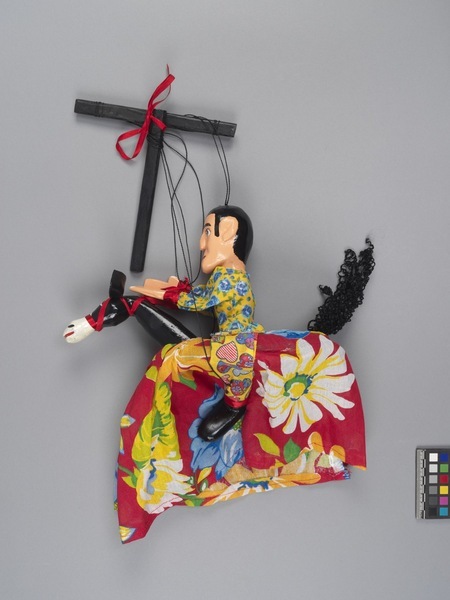String Puppet Item Number: 3352/7 from the MOA: University of British Columbia

Description
Mamulengo string puppet (marionette) of a man riding a 'burrinha' or ox characters. Heads, hands and feet are carved from wood and painted. The man has orange-pink skin, painted black hair, straight mouth with red lips, and large oval black eyes. He wears a long-sleeved yellow with blue floral shirt, and yellow with multicoloured heart pattern pants. The black and white ox has long black leather ears, and a curly black tail. A red with multicoloured floral pattern skirt extends down where the animal's body should be. The fabric is adhered(?) to the hands and head, and wrapped with shiny red ribbon at the wrists and neck, and across the ox's nose. The man is attached by several black strings to a wooden control bar composed of a single long piece of wood with one cross-bar.
History Of Use
The puppet represents a character from a form of popular puppet theatre, found in northeastern Brazil, called mamulengo. This type of theatre is prevalent in disenfranchised communities with ancestral ties to colonized Indigenous peoples and uprooted, enslaved Africans. Mamulengo performances are entertaining events that can last all night long, with puppeteers (mamulengueiros) using 70 to 100 puppets in one staging. The stages are pop-up stands (empanadas), made of brightly coloured, floral-printed cloth. The shows consist of short sequences (passagens), or skits from popular stories that expose the inequalities and dramas of everyday life, profiling stock characters such as rich landowners and peasant labourers. The whole is spun together with humour, satire, lively music, and audience commentary.
Item History
- Made by Jose Edvan Ferreira de (Maker) in Gloria do Goita, Pernambuco, Brazil during 2018
- Owned by Associacao Cultural de Amigos do Museu de Folclore Edison Carneiro before May 28, 2019
- Received from Associacao Cultural de Amigos do Museu de Folclore Edison Carneiro (Seller) and Museum of Anthropology Exhibitions Budget (Funding source) on May 28, 2019
What
Who
- Culture
- Brazilian
- Creator
- Jose Edvan Ferreira de (Maker)
- Previous Owner
- Associacao Cultural de Amigos do Museu de Folclore Edison Carneiro
- Received from
- Associacao Cultural de Amigos do Museu de Folclore Edison Carneiro (Seller) and Museum of Anthropology Exhibitions Budget (Funding source)
Where
- Holding Institution
- MOA: University of British Columbia
- Made in
- Gloria do Goita, Pernambuco, Brazil
When
- Creation Date
- during 2018
- Ownership Date
- before May 28, 2019
- Acquisition Date
- on May 28, 2019
Other
- Condition
- good
- Accession Number
- 3352/0007